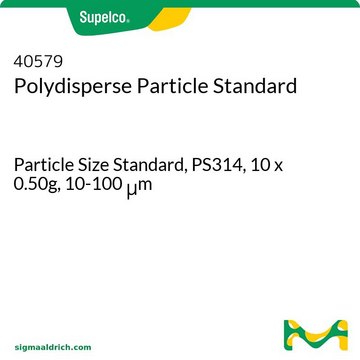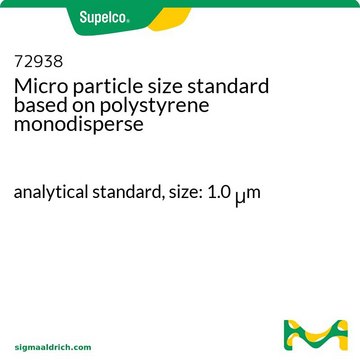94078
Polydisperse Particle Standard
Particle Size Standard, PS202, 10 x 0.10g, 3-30 μm
Synonym(s):
Particle size distribution standard
Sign Into View Organizational & Contract Pricing
All Photos(1)
About This Item
UNSPSC Code:
41116107
NACRES:
NA.24
Recommended Products
grade
analytical standard
form
particles
manufacturer/tradename
Whitehouse Scientific Ltd PS202
particle size
3-30 μm
application(s)
glass & ceramic
industrial qc
pharmaceutical
format
neat
Looking for similar products? Visit Product Comparison Guide
General description
Polydisperse Particle Standard (PS202, size: 3-30 μm) is a particle size standard, ideal to determine the particle size distribution (PSD) of a particle system.
This product is produced by using gravitational sedimentation, microscopy and Coulter counter.
This product is produced by using gravitational sedimentation, microscopy and Coulter counter.
Application
Used to standardize particle size equipment.
It used to determine the precision and reproducibility of laser diffraction particle sizer.
It used to determine the precision and reproducibility of laser diffraction particle sizer.
Features and Benefits
- suitable for routine instrument calibration checks, testing and corrections
- available as a neat sample
signalword
Danger
hcodes
Hazard Classifications
Eye Dam. 1 - Skin Corr. 1B
Storage Class
8B - Non-combustible corrosive hazardous materials
wgk_germany
WGK 1
flash_point_f
Not applicable
flash_point_c
Not applicable
ppe
Eyeshields, Gloves, type N95 (US)
Choose from one of the most recent versions:
Already Own This Product?
Find documentation for the products that you have recently purchased in the Document Library.
Customers Also Viewed
Soil variables that determine lead accumulation in Bidens pilosa L. and Tagetes minuta L. growing in polluted soils.
Salazar M J, et al.
Geoderma, 279, 97-108 (2016)
Revisiting the chronology and environmental conditions for the accretion of late Pleistocene-early Holocene Pampean loess (Argentina)
Torre G, et al.
Chemosphere, 213, 105-119 (2019)
Our team of scientists has experience in all areas of research including Life Science, Material Science, Chemical Synthesis, Chromatography, Analytical and many others.
Contact Technical Service









